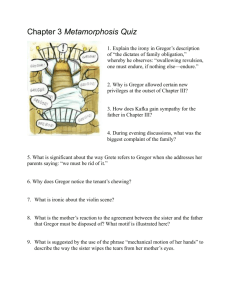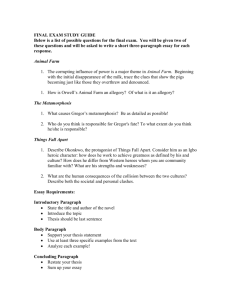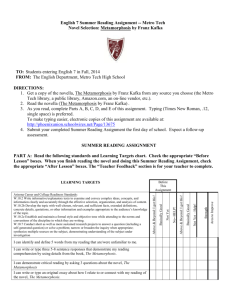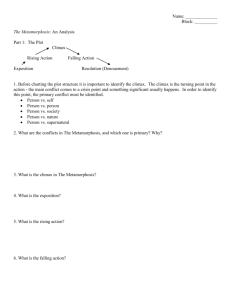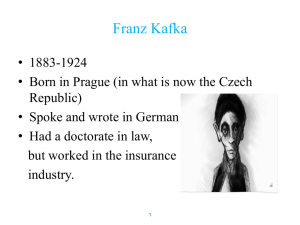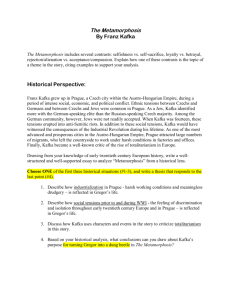Chapter 3
advertisement
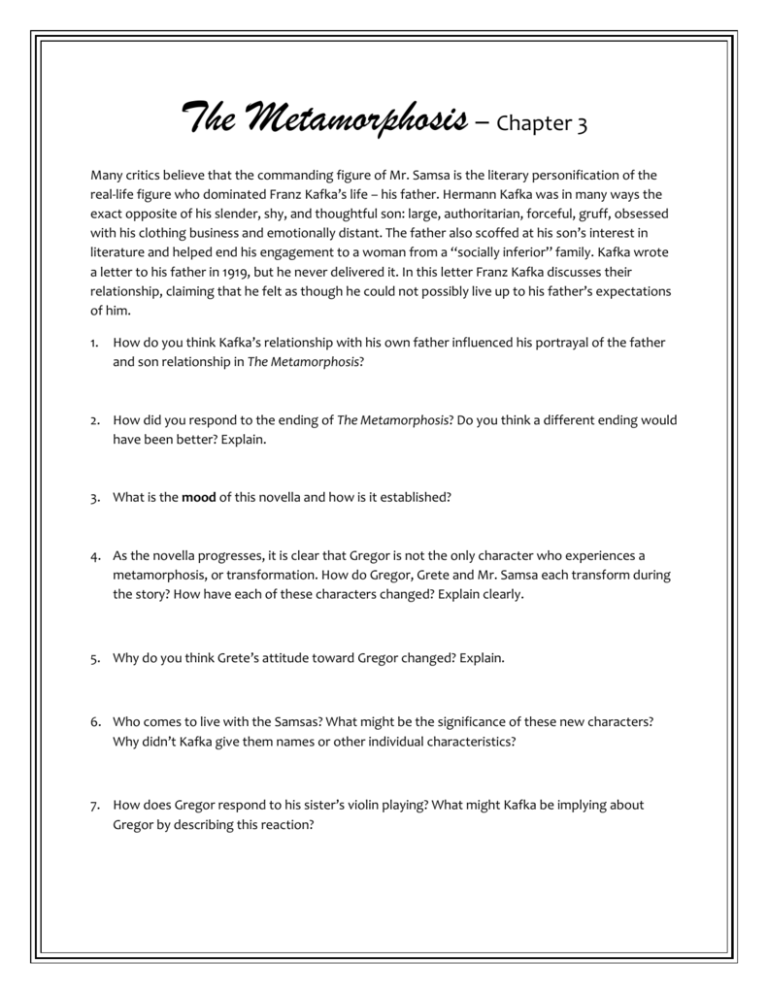
The Metamorphosis – Chapter 3 Many critics believe that the commanding figure of Mr. Samsa is the literary personification of the real-life figure who dominated Franz Kafka’s life – his father. Hermann Kafka was in many ways the exact opposite of his slender, shy, and thoughtful son: large, authoritarian, forceful, gruff, obsessed with his clothing business and emotionally distant. The father also scoffed at his son’s interest in literature and helped end his engagement to a woman from a “socially inferior” family. Kafka wrote a letter to his father in 1919, but he never delivered it. In this letter Franz Kafka discusses their relationship, claiming that he felt as though he could not possibly live up to his father’s expectations of him. 1. How do you think Kafka’s relationship with his own father influenced his portrayal of the father and son relationship in The Metamorphosis? 2. How did you respond to the ending of The Metamorphosis? Do you think a different ending would have been better? Explain. 3. What is the mood of this novella and how is it established? 4. As the novella progresses, it is clear that Gregor is not the only character who experiences a metamorphosis, or transformation. How do Gregor, Grete and Mr. Samsa each transform during the story? How have each of these characters changed? Explain clearly. 5. Why do you think Grete’s attitude toward Gregor changed? Explain. 6. Who comes to live with the Samsas? What might be the significance of these new characters? Why didn’t Kafka give them names or other individual characteristics? 7. How does Gregor respond to his sister’s violin playing? What might Kafka be implying about Gregor by describing this reaction? 8. Kafka strongly implies that Gregor starves himself to death. What other forces may have led to his death? 9. What effect does Gregor’s metamorphosis ultimately have on his family? What does this effect suggest about his relationship with is family? 10. What is the climax of the story? 11. In the first sentence of the novella, the word “bug” or “vermin” is ungeziefer in the original German. This word means “an unclean animal not suited for sacrifice.” How does this word relate to Gregor’s metamorphosis? Do you think his death can be seen as a sacrifice in any sense? Explain your response clearly. 12. How can The Metamorphosis be seen as a parable? If this story reveals a moral lesson, what lesson would that be? 13. What are the existentialist elements of this novella? 14. Kafka’s point of view in The Metamorphosis is limited third-person. He tells us Gregor’s thoughts and feelings only. We do not learn what the other characters are thinking or feeling unless they show us by their words or actions. In fact, much of the novella is a kind of interior monologue of Gregor’s thoughts and feelings, told by the narrator. This style has the effect of making Gregor’s inner reality seem more important than what actually occurs in the world around him. Choose one of the other characters from the novella and create a dramatic monologue based on his or her reactions to the events of Chapter Three. 15. What is a possible theme to this novella? 16. Kafka once wrote that literature should be an axe that smashes through “the frozen sea inside” the reader. Explain how The Metamorphosis did or did not have this effect on you. Allegory and Alienation in the Metamorphosis Many critics view The Metamorphosis as an Allegory. An allegory is a story where the characters and events are symbolic in attempt to teach a lesson or convey a moral message. Characters in an allegory are symbolic and their actions reveal truths about human existence. View Peter Kuper’s graphic novel version of The Metamorphosis 1. 2. 3. 4. Is Kuper’s visualization of Gregor’s life consistent with your vision? Does the music fit your understanding of the novella? Does it seem appropriate for the tone? Is this how you imagined Gregor to look? How does Kuper convey the bleakness of Gregor’s life? Consider the following quotation from critic Paul L. Landsburg: To be an exception or in the minority is the original social sin. When in society any group of men characterized by anomalous tastes or racial or social heredity is denounced as “vermin,” there will always be one group that from then on will see nothing but the other’s rottenness, and another fraction within the scorned group that will think and act as if they had truly been transformed into vermin. Paul L. Landsburg, Modern World Literature (Austin, Tex.: Holt, Rinehart, and Winston, 1996), 60. 5. Can you think of individuals or groups in society that could suffer the same kind of alienation and treatment that Gregor suffered? 6. Complete the handout: Gregor’s Metamorphosis as Allegory. Each group will complete one corner of the bug and then present their findings to the class. 7. After completing this activity, respond to the following question in your notebooks: What metamorphosis does the rest of the Samsa family undergo, particularly at the end? Discuss.
